The Chamberlain is the only surviving bridge of the original five. The others were replaced as the river rose due to flood control dams put in place over time.
Truss
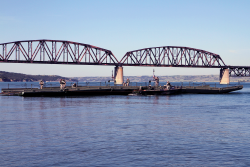
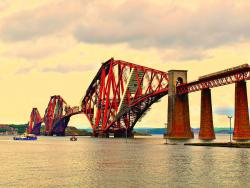
"The majestic Forth Bridge ... symbolises the tremendous achievements of Victorian engineers and the immense strides made in the technique of bridge design and construction since the dawn of the Railway Age..."
- Derrick Bennett, Bridges: Great Buildings of the World
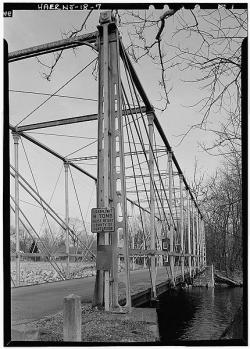
"Fink's truss design was one of a number of early patented solutions to [the problem of how] to carry a massive, moving weight (a train) over long spans (to avoid the expense of building piers and obstructing waterways) on easily erected bridges (often in rough terrain) with good long-term economy..."
- Kent Farnow Smith, "America's Oldest Functioning Iron-Truss Bridge," 1978
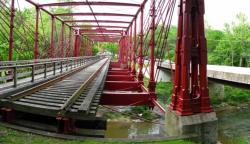
The design of the Bollman Truss Bridge-patented in 1852 and one of the first to use iron exclusively in all essential structural elements-was critical in the rapid expansion of American railroads in the 19th century. Replacing wooden bridges, which were cumbersome to build and vulnerable to decay, the Bollman Truss Bridge could be built relatively quickly and inexpensively, while providing the long-lasting qualities associated with metal. This allowed new rail lines to be built over long distances in a short period of time.

A 214-foot single-span covered wooden bridge, built above the cribs of stone in the AuSable River that served to break log jams and ice floes, collapsed during the winter of 1875 under the weight of a three-foot snowfall and high winds. The "Upper Bridge" (pictured) was built in its place.
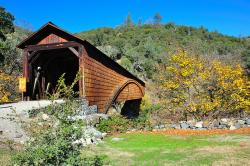
A product of the Northern California Gold Rush, the Bridgeport Covered Bridge is believed to be the longest, single-span, wooden covered bridge in the United States. Crossing the south fork of the Yuba River at a span of 233 feet, the bridge was built by the Virginia City Turnpike Company as part of a 14-mile toll road authorized by the California state legislature. The toll road was an essential link connecting Virginia City, Nevada, and the silver-producing Comstock Lode with the centers of California commerce.
Innovations
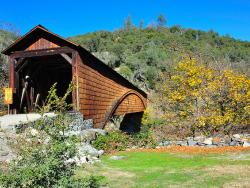
A product of the Northern California Gold Rush, the Bridgeport Covered Bridge is believed to be the longest, single-span, wooden covered bridge in the United States. Crossing the south fork of the Yuba River at a span of 233 feet, the bridge was built by the Virginia City Turnpike Company as…
Read More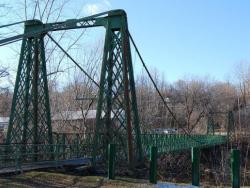
A 214-foot single-span covered wooden bridge, built above the cribs of stone in the AuSable River that served to break log jams and ice floes, collapsed during the winter of 1875 under the weight of a three-foot snowfall and high winds. The "Upper Bridge" (pictured) was built in its place.…
Read More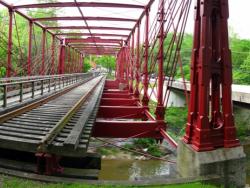
The design of the Bollman Truss Bridge-patented in 1852 and one of the first to use iron exclusively in all essential structural elements-was critical in the rapid expansion of American railroads in the 19th century. Replacing wooden bridges, which were cumbersome to build and vulnerable to…
Read More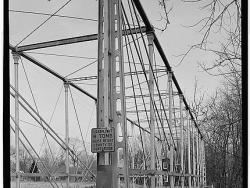
"Fink's truss design was one of a number of early patented solutions to [the problem of how] to carry a massive, moving weight (a train) over long spans (to avoid the expense of building piers and obstructing waterways) on easily erected bridges (often in rough terrain) with good long-term…
Read More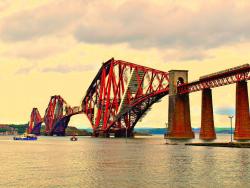
"The majestic Forth Bridge ... symbolises the tremendous achievements of Victorian engineers and the immense strides made in the technique of bridge design and construction since the dawn of the Railway Age..."
- Derrick Bennett, Bridges: Great Buildings of the World
Throughout…
Read More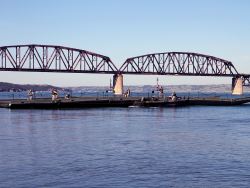
The Chamberlain is the only surviving bridge of the original five. The others were replaced as the river rose due to flood control dams put in place over time.
For its first 30 years of statehood, South Dakota was effectively two states. The Missouri river cut across the land forming a…
Read More

